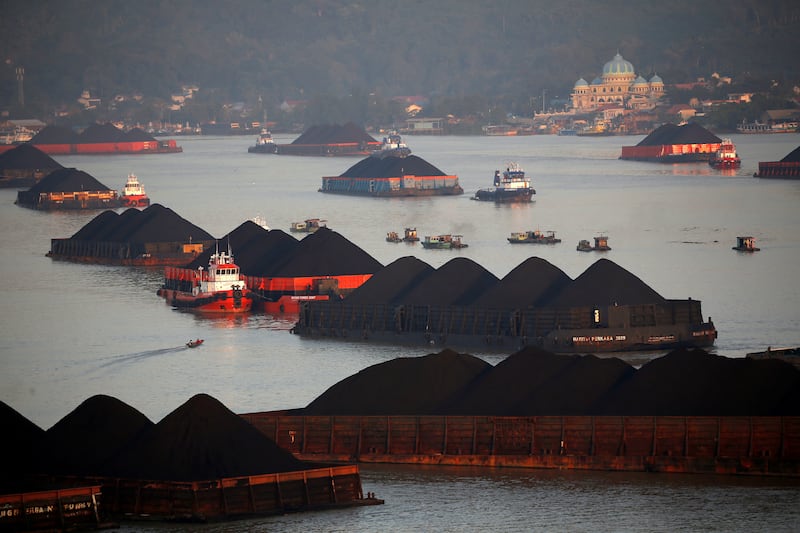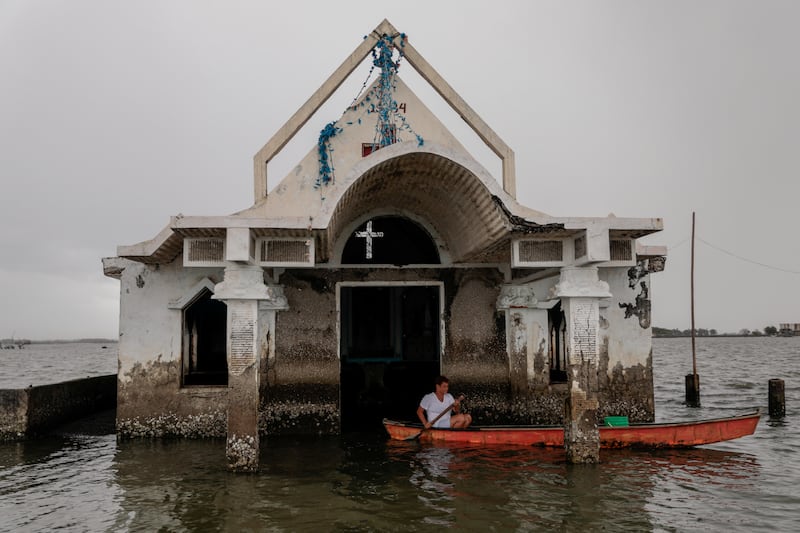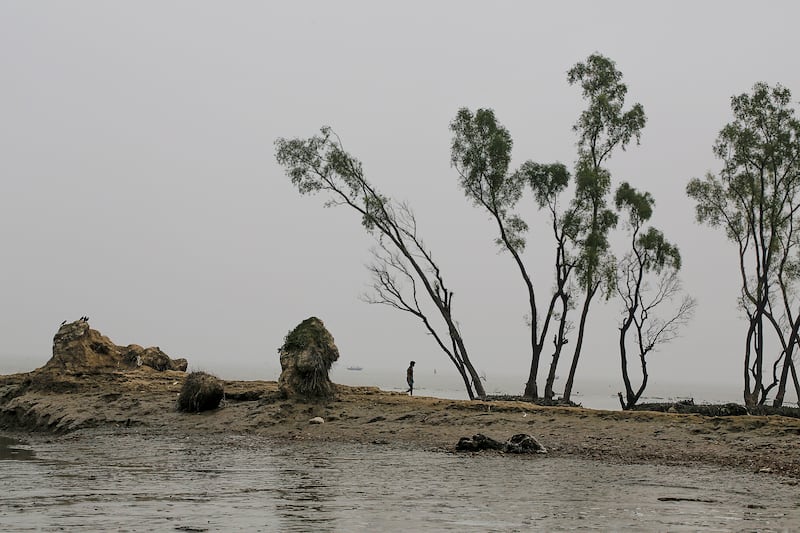Updated at 1:58 p.m. ET on 2021-10-29
Asian leaders are heading to Scotland where COP26, the most important global summit on climate change since the one that produced the 2015 Paris agreement, opens this weekend, after being postponed last year by the coronavirus pandemic.
South and Southeast Asia countries are among those on the front line of the climate crisis, ravaged by floods, storm surges and severe weather events such as droughts and extreme temperatures. The leaders of Bangladesh, Indonesia, Malaysia and Thailand are set to attend the summit.
Under the Paris accord, more than 190 countries agreed to keep global warming to “well below” 2 degrees Celsius (3.6 degrees Fahrenheit), through efforts to limit it to 1.5 C, which scientists say will help avoid the worst impacts of climate change.
“At 1.5 degrees warming, 700 million people would be at risk of extreme heat waves. At 2 degrees, it would be 2 billion,” Alok Sharma, the president of the U.N. Climate Change Conference (COP26) in Glasgow, said in a recent speech at UNESCO headquarters in Paris.
“That is why countries on the front line of climate change fought so hard ... For them, ‘1.5 to stay alive’ is not a hollow slogan. It is a matter of survival,” he said.
The Philippines, Thailand, and Bangladesh were among the top ten countries hit by extreme weather events in the last two decades, according to an analysis by Germanwatch, an environmental NGO based in Bonn, Germany.
At the two-week long conference that starts in Glasgow on Sunday, Paris Agreement signatory states will reassess their commitments and update their national action plans to reduce emissions.
Under the Paris deal, rich nations agreed to provide poorer ones with $100 billion annually to support climate action and adaptation, starting in 2020 – a commitment that has not been met.
The countries that signed the accord also agreed to cut greenhouse gas emissions to net zero by 2050. That means limiting emissions from human activity to a level that trees, soil, and oceans can absorb.
Countries that make up 80 percent of the global economy have now committed to the net-zero target, one of the main talking points at COP26, Sharma said.
Ending use of coal – a major source of greenhouse-gas emissions – is a “personal priority” for Sharma, but it could turn into a stumbling block at the conference because countries including China and India refuse to abandon coal production and consumption.
Asia accounts for 75 percent of international coal demand, according to the International Energy Agency (IEA).
China, India, Indonesia, Bangladesh, Vietnam and Turkey account for more than four-fifths of the world’s remaining pipeline of coal power plants as of July 2021, said a report by think-tank E3G released in September.
In 2019, Indonesia was the top exporter of coal for power generation, supplying 40 percent of the world market, while Malaysia and the Philippines were among the top five importers of coal, according to the Observatory of Economic Complexity.

Indonesia
Southeast Asia’s largest and most populous country is the eighth most polluting one in the world with 2 percent of global greenhouse-gas emissions to its name, according to the World Resources Institute.
At present, Indonesia draws 60 percent of its own energy supply from coal, but aims to switch to renewable sources supplying 85 percent of its energy needs by 2060.
During his appearance at COP26, President Joko “Jokowi” Widodo is expected to speak about Indonesia’s commitment to net-zero emission by that year, government officials said.
“The government is also in the process of finalizing the draft Presidential Regulation on the Economic Value of Carbon. All coverage of the carbon economy value is directed to support efforts to achieve the (Paris) target,” Laksmi Dewanti, director general of climate change at Indonesia’s environment ministry, said during an online discussion last week.
Indonesia has set a goal for 2030 of reducing its greenhouse-gas emissions by 29 percent. Its Ministry of Industry says the energy sector now accounts for nearly half of the country’s emissions, and that automotive emissions make up about one fifth of its overall emissions.
Starting in April 2022, individual people and industries will be subject to a carbon tax of 30 rupiah (U.S. $2.1) per metric ton of CO2e (carbon dioxide equivalent). But the tariff is too low and may not be effective in changing public behavior to switch to clean energy, said Fabby Tumiwa, executive director of IESR, an Indonesian think-tank.
“In the long term, our competitiveness will continue to be eroded,” Fabby told BenarNews.
The rate of deforestation, meanwhile, fell to its lowest level in 20 years last year – due to a three-year moratorium on new palm oil plantations that has since been lifted. Still, the country lost 115,459 hectares of forest cover in 2020, the Ministry of Environment and Forestry said.
According to Greenpeace, the clear-burning of forest land to make way for plantations has generated nearly 104 million metric tons of carbon emissions during the past 19 years. That equals 33 times the annual emissions from powering all the homes in the Indonesian capital.
Philippines
The Philippines was the among the countries worst affected by extreme weather between 2000 and 2019, ranking fourth in the world, according to Germanwatch’s Global Climate Risk Index for 2021.
The Philippines does not have net-zero plans as of now, but it has announced a moratorium on the building of new coal-powered plants. The Philippines COP26 delegation will be led by finance and foreign affairs secretaries.

After deriding international climate-change talks as “nonsense” in 2016 and threatening to quit the Paris agreement, President Rodrigo Duterte reversed course this year.
“The Philippines accepts its share of responsibility and will do its part to avert this collective disaster. We have submitted our first Nationally Determined Contributions (NDCs), with a target to reduce greenhouse gas emissions by 75 percent by 2030,” Duterte said in a speech to the U.N. General Assembly in September.
“But this contribution will be rendered useless if the biggest polluters – past and present – choose to do ‘business as usual.’ We therefore appeal for urgent climate action, especially from those that can truly tip the balance,” he said.
He also urged developed nations to fulfill “their longstanding commitment to climate financing, technology transfer, and capacity-building in the developing world.”
“This a moral obligation that cannot be avoided. Our world’s transition to a green economy must not be at the expense of developing countries' economic vitality,” he said.
Bangladesh
Prime Minister Sheikh Hasina will lead a nearly 100-strong Bangladeshi delegation to COP26, according to Mirza Shawkat Ali, who directs the climate-change cell at the Ministry of Environment.
“The main message Bangladesh wants to convey at the Glasgow COP is that the global temperature rise must be kept within 1.5 degrees Celsius as agreed in the Paris Agreement,” M. Ziaul Haque, a member of the delegation, told BenarNews.
“Our call is to the G20 countries, who emit nearly 80 percent global emissions, to reduce global emissions by 45 percent before 2030 compared to the 2010 level,” he said, adding Bangladesh has been “experiencing an irreversible impact, as well as loss and damage.”
Bangladesh, where a third of its population is at risk of displacement from rising sea levels, was ranked seventh in the Germanwatch’s list of countries most affected by extreme weather events between 2000 and 2019.
“We are not only making a call to the developed countries to cut emissions, but we have also already taken actions to cut emission in Bangladesh by cancelling coal projects,” he said.
Developed nations must allocate funds in addition to overseas development assistance and not as part of it, Ali told BenarNews. He also said Bangladesh opposes the involvement of the private sector in the adaptation initiatives, as proposed by the developed countries, instead of state agencies.

Thailand
Varawut Silpa-archa, the minister of natural resources and environment, said last week that Thailand would push for a strategy of achieving low emissions over the long term, with a goal of reaching net- zero emissions by 2065.
The government also plans to increase the share of electric vehicles to one in three vehicles by 2030, and have half of new power plants produce electricity from renewable energy sources.
Currently, Thailand’s pledges and plans include reducing its greenhouse-gas emissions by 20 percent by 2030 compared with 2005 levels, environmental expert Dominic Chakrabongse wrote recently in the Thai Inquirer.
Much of this will rely on the manufacturing and transportation sectors making drastic cuts – 74 percent of the entire target, he said, adding, “Whereas the largest emitter – power production – is only required to cut emissions by 20 percent.”
Thailand is ranked ninth on the Germanwatch’s long-term climate risk index.
“The Thai government has implemented several policies to address climate change … However, all of these policies fail to uphold “climate justice,” said Tara Buakamsri, country director for Greenpeace Thailand.
“All of these policies, if implemented without regard for human rights, will exacerbate social conflict, poverty, and future epidemics.”
Malaysia
Prime Minister Ismail Sabri Yaakob pledged last month that Malaysia, among the top 25 emitters of greenhouse gases, would become carbon neutral by 2050 at the earliest.
“I would like to stress that the climate-change agenda and green technologies would be the country’s priority under the current administration,” he said.
Malaysia aims to reduce the intensity of greenhouse-gas emissions across the economy by 45 percent by 2030 and increase renewable energy generation, according to the government plan.
It also plans to maintain at least 50 percent of the country's forest cover.
Malaysia is eighth highest in cumulative per-capita emissions from 1850 to 2021, largely “as a result of emissions from deforestation,” according to Carbon Brief, a U.K.-based policy institute.
Shariffa Sabrina Syed Akil, founder of local environmental group PEKA, expressed skepticism that could fulfill a pledge of becoming carbon neutral by 2050.
“Malaysia will miss the target by a mile with the current seriousness shown by the government … We are still in the mindset of blaming disasters on Acts of God,” Shariffa Sabrina told BenarNews.
Jason Gutierrez in Manila, Ahmad Pathoni in Jakarta, Kamran Reza Chowdhury in Dhaka, Kunnawut Boonreak in Chiang Mai, Thailand, and Hadi Azmi and Muzliza Mustafa in Kuala Lumpur contributed to this report.
